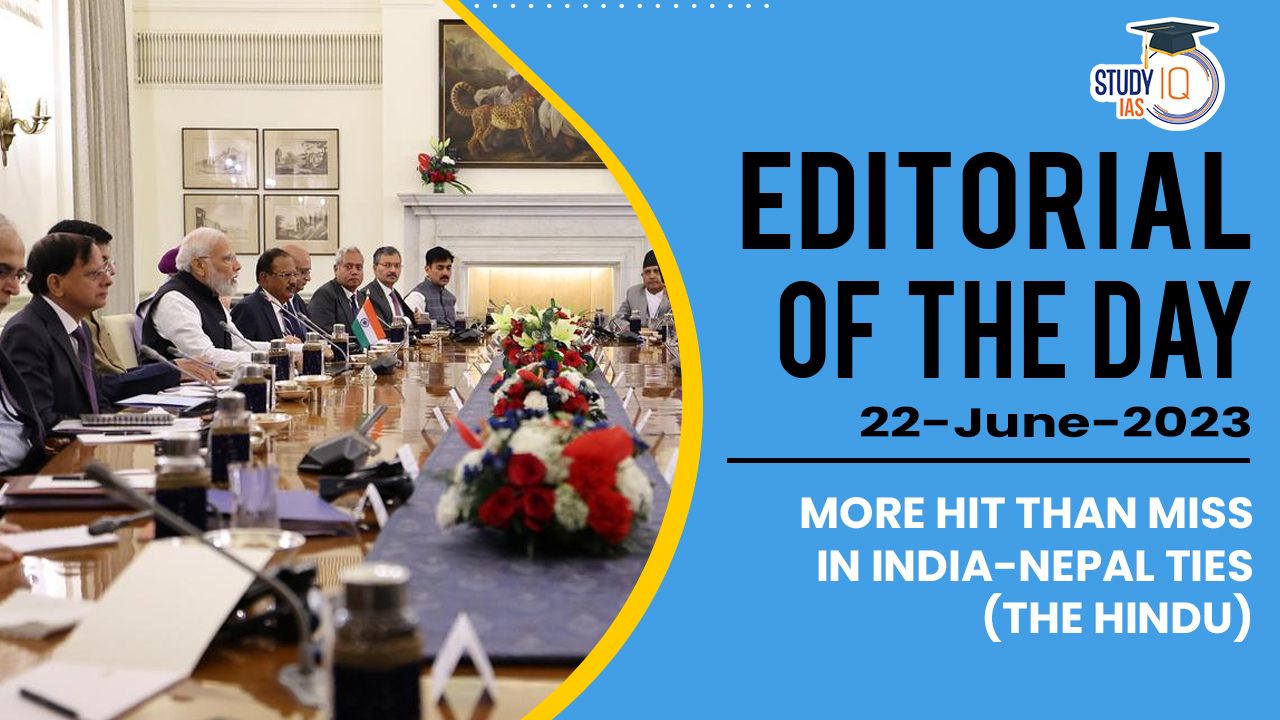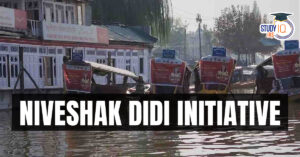Table of Contents
Context: The article is discussing the recent visit of Nepal’s Prime Minister Pushpa Kamal Dahal, also known as Prachanda, to India and the positive outcomes and progress made in the bilateral relationship between the two countries. It highlights that compared to Prachanda’s previous visits in 2008 and 2016, this visit has yielded more concrete results and successfully avoided controversial issues. The article also provides the changed power dynamics in Nepal and the falling out between political heads. The article briefly mentions Nepal’s transition to a federal republic and the political stability it has achieved, allowing the government to focus on the economy. It refers to India’s “neighbourhood first” policy and its emphasis on connectivity with Nepal through highways, infoways, and transways. It acknowledges that the relationship between India and Nepal faced challenges, including an economic blockade in 2015, but highlights the recent progress in repairing the relationship and the renewed focus on connectivity between the two countries.
Background
Recently, Nepalese Prime Minister Pushpa Kamal Dahal came on an official visit to India, seeking to enhance cooperation in power, transport and tourism.
- Export of hydropower: India-Nepal have signed a series of agreements, including export of Nepal’s hydropower to Bangladesh through Indian Territory.
- A long-term Power Trade Agreement was signed, aiming to set a target of importing 10,000 MW of electricity from Nepal in the coming years.
- Infrastructure assistance: NHPC and VUCL (Vidyut Utpadan Company Ltd.) of Nepal have signed an agreement for the development of Phukot Karnali Hydroelectric Project and Lower Arun Hydroelectric Project.
- Access to inland waterways: Both the sides signed the revised Treaty of Transit under which Nepal will get access to India’s inland waterways.
- Railway connectivity: Both sides jointly inaugurated a cargo train from Bathnaha in India to Nepal Customs Yard. The rail link was built with an Indian grant.
- Upgradation of petroleum pipeline: Foundation was laid for development of Phase-II facilities as part of the Motihari-Amlekhgunj Petroleum Pipeline.
- Religious tourism: The projects related to the Ramayana Circuit were discussed.
India-Nepal Ties: Significance
- Economic significance:
- Trade: Nepal shares a border with 5 Indian states. Hence an important point of trade and economic exchange.
- Energy security: India and Nepal share many trans-boundary Himalayan rivers with huge hydropower potential.
- Foreign exchange: Remittances sent from India are one of the major sources of foreign exchange.
- Strategic significance:
- Buffer state: Nepal acts as buffer state between India and China. It prevents any future chances of aggression.
- Internal security: Cooperation of Nepal is necessary for curbing cross-border smuggling of weapons, fake currency and narcotics.
- Cultural significance:
- Pilgrimage sites: Many Hindu and Buddhist religious sites are in Nepal making it an important pilgrimage site for Indian citizens.
- Common religion: Majority of citizens in India and Nepal are Hindus, forming a major civilisational link between the two nations.
- Diaspora: Nepali diaspora in India and Indian workforce in Nepal act as people-to-people link.
Areas of Cooperation between India and Nepal
| Trade and Economy |
|
| Connectivity |
|
| Defence cooperation |
|
| Cultural cooperation |
|
| Energy cooperation |
|
| Assistance |
|
| Multilateral Partnership |
|
Decoding the Editorial
The article discusses the politics in Nepal under the leadership of Prachanda and the evolving relations between India and Nepal.
- Prachanda’s political journey: Prachanda led the Maoist Centre party in the elections and initially formed a coalition with the Nepali Congress (NC). However, there was a disagreement over the post of Prime Minister, leading Prachanda to switch sides and align with the K.P. Sharma Oli-led UML party. Prachanda became the Prime Minister but faced criticism for his decision.
- Souring of relations between Oli and Prachanda: Tensions rose between Prachanda and Oli, with Oli accusing Prachanda of betrayal while Prachanda claimed he wanted to ensure political stability by involving all parties. The alliance between Oli and Prachanda collapsed, and the UML withdrew support, prompting Prachanda to return to the Nepali Congress for support.
- Power-sharing arrangement: A complex power-sharing arrangement was worked out, with Prachanda serving as Prime Minister for two years, followed by Madhav Nepal for a year, and then Sher Bahadur Deuba of the Nepali Congress for the remaining two years.
- Nepal’s transition to a federal republic: Nepal transitioned to a federal republic in 2008 with the abolition of the monarchy. This process has been politically tumultuous but largely peaceful. A new constitution was adopted in 2015, and subsequent elections have been held to establish the government’s legitimacy.
- Evolving relations between India and Nepal: The article mentions Prime Minister Modi’s visit to Nepal in 2014, where he emphasized the “neighbourhood first” policy and focused on connectivity through highways, infoways, and transways. However, relations faced challenges in 2015 with an economic blockade. The repairing of the relationship has been a slow process, but there are now visible results, leading to the revival of the “neighbourhood first” approach.
Hydropower Cooperation:
The article is discussing the cooperation between India and Nepal in the hydropower sector and the potential of Nepal’s hydropower resources.
- Hydropower potential in Nepal: Nepal is blessed with a significant hydropower potential of 50,000 MW, which is economically viable. However, until a decade ago, its installed capacity was only 1,200 MW, leading to a reliance on electricity imports from India.
- Increasing installed capacity and power exports: Currently, Nepal has increased its installed capacity to 2,200 MW and has the ability to export power to India during the season. A 400 KV transmission line is operational. In 2021, Nepal exported 39 MW of power, which increased to 452 MW the following year, earning significant export earnings.
- Reduction in power import dependence: Nepal’s dependence on electricity imports from India has decreased from 20% to 10% over the last five years. This indicates the progress made in enhancing Nepal’s domestic power generation capacity.
- Long-term power trade agreement: Both India and Nepal have finalized a long-term power trade agreement with the target of exporting 10,000 MW of power within a 10-year timeframe.
- Hydropower projects and cooperation: Several hydropower projects and cooperation initiatives have been undertaken. Projects like the 900 MW Arun III, 695 MW Arun IV, 669 MW Lower Arun, and 480 MW Phukot-Karnali have been signed or initiated by different entities such as SJVN and NHPC.
- Infrastructure development: Efforts are being made to enhance infrastructure to facilitate the movement of goods and people between India and Nepal. Integrated check posts, railway lines, and petroleum pipelines have been inaugurated or planned to improve connectivity and trade.
Areas of Controversy between India and Nepal:
According to the excerpt, the areas of controversy between India and Nepal are:
- Agnipath scheme: The controversy revolves around the revision of the terms impacting the recruitment of Gurkha soldiers into the Indian Army’s Gurkha regiments. The issue needs to be discussed between the two armies and the relevant defence and finance officials to find a resolution.
- Kalapani boundary issue: It involved a unilateral change in Nepal’s map and a constitutional amendment. Resolving this issue requires political wisdom and understanding, and it may take time to find a lasting solution.
- India-Nepal Treaty of Peace and Friendship of 1950: This treaty is seen as unfair by some in Nepal, who believe it was imposed on them. There is a demand for its review and updating. Clearing historical misunderstandings and addressing the concerns of both countries would be necessary to facilitate substantive talks on this matter.
Way Forward
- To handle these irritants, the article suggests avoiding public disagreements and controversial issues.
- It emphasizes focusing on economic ties and rebuilding trust, through focus on the HIT acronym (Highways, Infoways, and Transways) to enhance connectivity and cooperation.
- Clearing historical cobwebs and engaging in objective discussions that address the concerns of both countries can pave the way for finding resolutions to these controversies.
- It highlights the importance of diplomatic efforts, political wisdom, and understanding in handling these sensitive issues.
Beyond the Editorial
Major challenges in India Nepal Relations:



 Niveshak Didi Initiative Phase 2 launche...
Niveshak Didi Initiative Phase 2 launche...
 Central Pollution Control Board (CPCB) R...
Central Pollution Control Board (CPCB) R...
 Foreign Contribution Regulation Act (FCR...
Foreign Contribution Regulation Act (FCR...





















